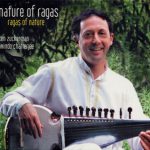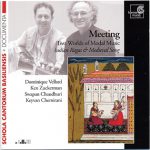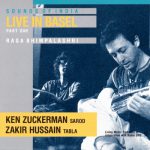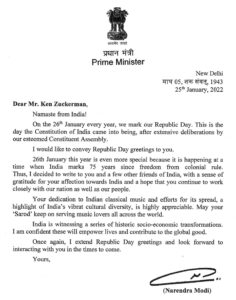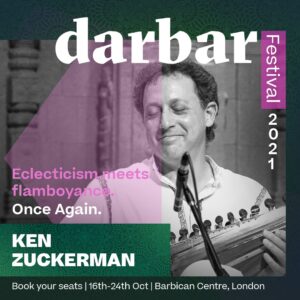Ragas d’equinoxe
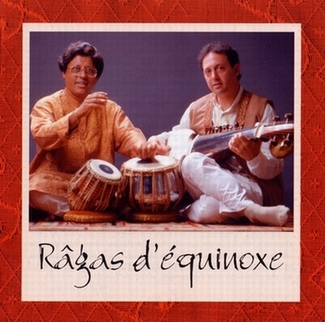
To listen to a sample from Track 2, please click here:
To order this CD direct from kenzuckerman.com please click here.
“Notes d’quinoxe” is a biennial music festival which takes place in Delemont, the capital city of the Swiss french Canton of Jura. Co-produced by the Swiss public Radio “Radio Suisse Romande / Espace”, the festival is dedicated to presenting musical traditions from around the world. During three consecutive days of performances and live radio broadcasts, music lovers of this region are treated to diverse musical expressions representing cultures from all continents.
The music:
Raga Bageshri Kanra
A specialty of Ustad Ali Akbar Khan, who has often performed and taught it, this raga is a blend of the evening raga Bageshri and ragas of the Kanra (or Kanada) family. Conveying moods ranging from joy to heroic and passion to pathos, it offers many possibilities for expression and improvisation. The highlight of the performance, Bageshri Kanra is first developed in a solo section by Ken Zuckerman. Following the traditional classical forms, it begins with a long non-rhythmic introduction (alap), followed by an increasingly rhythmic exploration of the important melodic motives of the raga (jor). In the following section, Anindo Chatterjee provides both accompaniment and solo improvisations in the rhythmic cycle of teental (16 beats), in both slow and fast tempi, culminating in the climactic finale known as jhala.
Raga Jogiya Kalingra
A creation of Ustad Ali Akbar Khan, raga Jogiya Kalingra is a fasinating mixture of several ragas, with an emphasis on raga Jogiya, mentioned in reference to the yogis who begin meditating before dawn. It is a very special rÃga, played late at night, just before the first light of dawn and for Ken Zuckeman, it is this ambiguous expression of a “time between times” which contributes to its unique beauty.
Raga Bageshree Kanra (traditional, arr. Ken Zuckerman)
1. Alap “Jor” Jhala (21’11)
2. Ghat in t’ntâl (28’58)
Raga Jogiya Kalingra (Ustad Ali Akbar Khan, arr. Ken Zuckeman)
3. Alap and ghat (11’14)
Ken Zuckerman: Sarod
Anindo Chatterjee: Tabla
Antonella Carollo: Tambura
Producer: Luc Terrapon
Artistic director and text: Vincent Zanetti
Recording: Salle Saint-Georges in Delémont, 21 September 2002, by Philippe Hamilton during “Notes d’équinoxe”, a RSR Espace 2 and town of Delémont co production
The Sarod
The sarod is a lute with a solid body hollowed out from a single piece of teak or rosewood. Its neck has a wide fretless fingerboard covered with metal, which allows extensive use of glissandi and other sliding ornaments, spanning more than an octave on each string. The main body of the instrument serves as a resonance chamber and is covered with a a goatskin, which supports the bridge. Similar to the Afghan rubab in its general shape, skin covering and use of sympathetic strings, the sarod is well documented in India from the 16th century Moghul courts. During the 18th century it acquired its now characteristic metal fingerboard and increased number of sympathetic strings.
Today there are two common types of sarod played throughout North India. One type is represented by artists like Amjad Ali Khan, having two rhythmic drone strings, four to five melody strings and sympathetic strings. The other type owes much of its development to Ustad Allauddin Khan andhas been made world famous by his son, Ustad Ali Akbar Khan. This instrument has an additional bridge, more sympathetic strings and is usually played at a higher pitch. Ken Zuckerman plays this latter type of sarod.
The artists:
A disciple of the great Ustad Ali Akbar Khan for more than 30 years, Ken Zuckerman has had the privilege of accompanying his master on many international stages and is now among the recognized ambassadors of the art of the sarod, both in India as well as Europe and the United States. Director of the Ali Akbar College of Music in Switzerland, he also teaches North Indian classical music and Medieval music at the Music Conservatory of Basel . He regularly appears in concert with some of India’s most respected tabla virtuosos: Swapan Chaudhuri, Zakir Hussain, and as in this recording, Anindo Chatterjee.
Born in a family of musicians, Anindo Chatterjee began learning the tabla at the age of four. Two years later he became the disciple of the renowned performer/teacher, Padmabhusan Jnan Prakash Ghosh. This maestro was famous for his mastery of manyof the most important gharanas (traditional schools) preserving the art of the tabla -Ajara, Benares, Delhi, Lucknow, Punjab, as well as that of Farrukhabad, the style in which he had been brought up. This variety and depth of rhythmic knowledge now also characterizes the playing of Anindo Chatterjee and has made him one of the most respected and sought after tabla players in India today.

